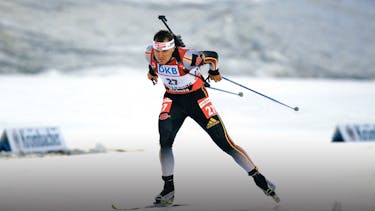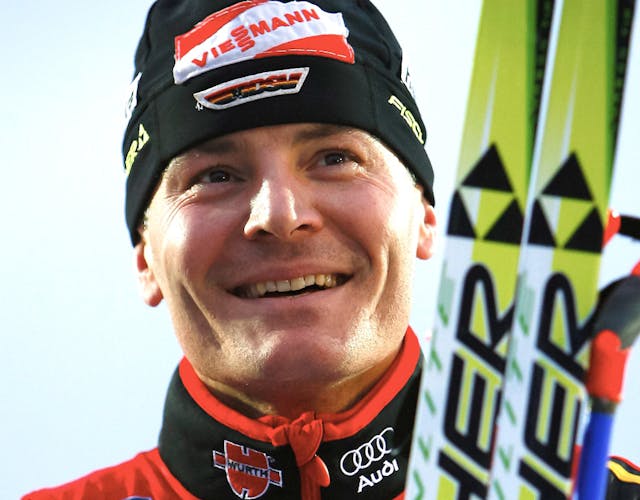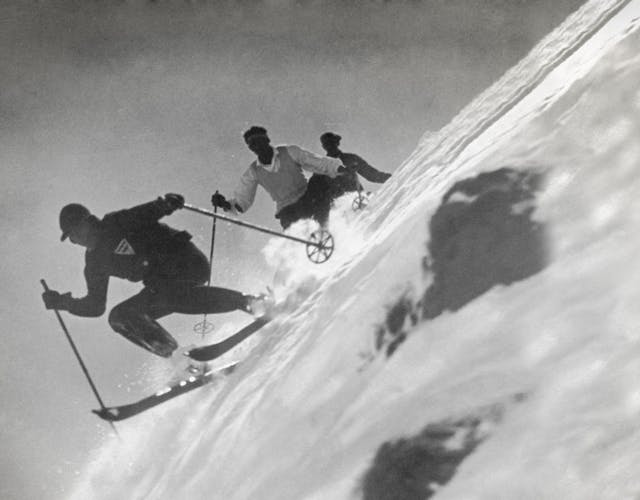„I ALWAYS FELT THAT AS AN ATHLETE I AM LISTENED TO.”“
With four Olympic and seven World Championship gold medals, Sven Fischer is one of the most successful German biathletes. Twice winner of the overall World Cup, now a co-commentator on television, he stayed loyal to Fischer throughout his entire World Cup career. “I always felt that as an athlete I am listened to – that Fischer implement my ideas and assimilate my feedback,” Fischer recounts. “For me skiing with Fischer was always a primary aim – if only because of my name.”
How did your biathlon career begin?
I was eleven when I started biathlon, and I learnt to shoot with an airgun at 12, 13, 14. After ten years’ training I became a contestant in the World Cup.
How did you get connected with Fischer?
For me skiing with Fischer was always a primary aim – if only because of my name. But in my eyes Fischer always stood for quality, too. I was born in what was then the German Democratic Republic. There were masses of Germina skis around, so I grew up with Germina. When I joined the squad I was told: “Now you can choose, which brand would you like to ski on?” Then I said: “Fischer!” To which the reply was, I’m too far down the list and I can’t have Fischer skis. Then I skied on Atomic for two years, but always with the proviso that I really want to have Fischer skis. In 1992 the issue of which ski you preferred came up again, and I’d moved quite some way up the ranking list. So at last I was allowed to switch. It was my last Europa Cup season, and in the first season I skied on Fischer I immediately qualified for the World Cup.
Do you have an anecdote about Fischer to tell us?
Yes, Fischer in two different ways. We had training camps in Obertauern in Austria, together with the potential candidates for the World Cup. The qualifying contests for the World Cup team were held there, too. We had summer and winter contests, and the results were added together. In summer I had won one of the contests; but that winter I still needed some points if I was to get into the team. I can see myself now during the ski test! Suddenly one of the others who were testing at the same time said to me: “Which skis are you using?” I said they were my competition skis. To which Fritz Fischer replied: “But my skis are much better than the ones you’re standing on at the moment. It’ll be better for you to take mine.” And I said: “If you let me use them ….” And he let me. I had prepared my skis all by myself, and they had some ridges and
bumps. His skis had of course been prepared beautifully by a service man, Raik Dittrich. On Fritz Fischer’s Fischer skis I wasn’t the best in the qualifying contest, but I was far enough up the ranking list to qualify for the World Cup.
What was working with Fischer like?
Ever since that ski test in 1992 I had been a contestant in the World Cup, and it was absolutely clear to me that I would always stay loyal to Fischer, out of gratitude. In the long years together there was one year in which there were difficulties; but we put our heads together and found a solution. And it worked really well. I managed to notch up a lot of successes. Obviously, with so many skis in stock, we occasionally picked the wrong ski, and occasionally put the wrong wax on. Naturally that happened now and again. But in all those years I always did well with Fischer. The most important aspect for me was that I was always in close touch with the service men – whether it was Gerhard Thaller or Hans or Franz Gattermann, Gerhard Urain, Michael Grossegger. We were always in close touch. Then Tanja Winterhalder joined in. That’s how the team took shape. And I’d say: that’s a team that really works.
„I wanted a top-rate product rather than some sort of bonus for winning.“
Were there other interesting offers?
Oh yes! In 1993/94 the old Germina company made great efforts to lure competitors with cash. But I wanted a top-rate product rather than some sort of bonus for winning. I wanted to have really cutting-edge skis. Instead of four pairs of skis I wanted to have the option of, say, having five, six or seven pairs and getting an extra pair at some point if the need arose. That mattered much more to me.
What was so special about Fischer, apart from the coincidence of names?
I found it very interesting that I was able to express opinions. I always felt that as an athlete I am listened to. For instance when we got the smooth-base ski in 1991/92 – long before any sort of structured finish. At that point I said: Hey, there’s a kind of fir-tree, I reckon it’s pretty good. So it was tried out – and lo and behold, it worked. Then again, we tested these skis with a cap design. Then there were various skis with this extravagant sidecut. Then there was a special sidecut for me – they said, we’ll make one more, but really slender. We were involved in all these developments at the time. I was all for that, I felt Fischer implement my ideas and assimilate my feedback. At the end of my career I was able to ski in Fischer boots, too. This development was also meteoric. I reckon both products are extremely competitive, and Fischer is the market leader. The main thing is for work to continue on that front, so that it stays that way.
Have you still got lots of old skis at home?
We are a partnership, and you can’t hang on to all the old skis. Skis always got returned, too – like replacing stock. If you hand something back, you get something new. There was always an element of rotation. But I did hang on to the top skis with the markings that I was successful with. I still have the skis at home from almost all the highlights. In the course of 15 years’ World Cup a fair number of skis accumulate; they’re carefully stashed away in my cellar. (grins)
Is there one ski which has pride of place?
Fritz’s skis certainly would, but of course I handed them back to him. But the skis I won the Olympic relay race in Lillehammer – I feel they’re very special. And they have a special history, too; they were among the very first cap skis, predominantly in yellow, if anyone remembers 1994. They were amazingly hard. Originally they were assigned to the Norwegian cross- country racers around Bjørn Dæhlie, who were very successful at the time. But they gave them back to the company, because they found them far too hard. So then I was given them, the idea being “See what they’re like”. And that’s the pair I used at the Olympic Games in Lillehammer.






